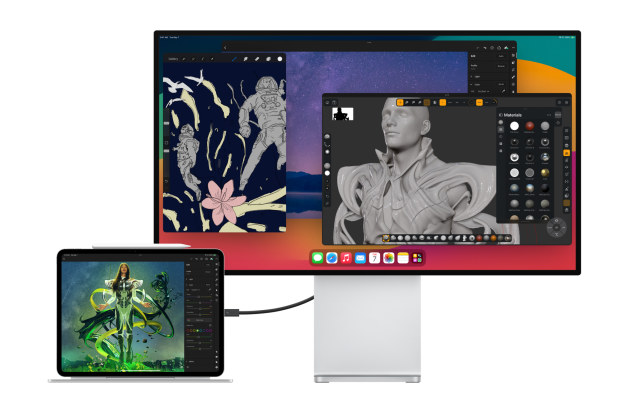Opinion

Will Apple’s new iPad Pro finally replace your laptop?
Apple says its new M4 iPad Pros will have better AI, better performance and better battery life than laptops. But don’t throw away your laptop just yet.
John DavidsonColumnistThe two things we were hoping Apple would do in its iPad launch were: turn the iPad Pro into the proper laptop replacement it should have been years ago, and cram as many AI capabilities into it as possible, so there was finally a reason to have that much processing power in a device you can use while sitting on the loo.
We got one of them.

Apple’s new iPad Pro connects to an external display for improved multitasking. But can you use it like a proper computer?
Apple says it’s put “outrageously” fast artificial intelligence capabilities into the chip that will power the new 11 and 13-inch iPad Pros announced overnight.
That chip, interestingly enough, is brand new.
It’s the Apple Silicon M4 chip, rather than the existing M3 chip one might have ordinarily expected to go into this year’s iPad Pros, given that last year’s models used the M2 chip.
Apple said it skipped the M3 because it needed the extra graphics processing power available in the M4 to power the new OLED screen on the iPad Pro.
Or, should I say, OLED screens. The display on the iPad Pro is two OLED panels sandwiched on top of each other, Apple says, because having just the one OLED panel wouldn’t be bright enough. Weird, given that the OLED panels are very bright nowadays, but OK.
The M4 also brings improved performance-per-watt compared with previous M chips, something Apple said it also needed in order to make the new iPad Pro as slim as it is.
When you make a device slim – and Apple says the new iPad Pro is its slimmest device, slimmer than an iPhone and slimmer than the iPod Nano from 2005 – you put constraints on how much power its parts can use because using power equates to generating heat, and in ultraslim devices, there’s almost no room to dissipate that heat.

The new Magic Keyboard looks like a laptop keyboard.
The new M4 chip, Apple says, offers the same performance as the M2 chip in the current iPad Pros, but uses just half the power.
(Alternatively, it can offer four times the performance of the M2 chip, generating some amount of heat that Apple didn’t mention in its launch event.)
So anyway, those are the main two reasons Apple gave for skipping the M3 and heading straight to the M4: better graphics performance and better performance per watt.
The fact that the M4 just happens to have “outrageously” good AI capabilities almost feels like a happy coincidence, the way Apple tells it, which is a stroke of luck for a company scrambling to catch up with the AI craze.
The new chip has a brand new neural processing unit (NPU) capable of 38 trillion operations per second (which we are meant to understand is a lot), plus it has AI accelerators built into its central processing unit (CPU), plus it has that faster graphics performance I mentioned earlier that can also be harnessed for AI processing.
According to Apple, all of that adds up to AI performance that is faster than the AI performance in any of the new AI-oriented Windows laptops that are now appearing.
That’s not the only way Apple likened the new iPad Pro and its M4 chip to Windows laptops. Officials also said the chip in the new tablet offers the same performance as a laptop chip, but uses only one-quarter of the electrical power.
All of which is to say, it’s as fast as a laptop, has better AI performance than a laptop, and should have a battery life that will crush any performance-comparable Windows laptop on the market.
So why not let us use it as a laptop?
Other than an improved Magic Keyboard that now has function keys, and other than a brief mention of the Stage Manager software in iPadOS that lets “advanced users” open multiple windows at once and attach external displays, there wasn’t much in Wednesday’s announcement for people who want from Apple the same thing Windows users have had for many years: a touch-screen tablet/laptop hybrid you can use with a pen.
Indeed, describing people who want to multitask on the iPad Pro as “advanced users” tells us everything we need to know about Apple’s thinking here.
The iPad Pro and the MacBook are still being kept at arm’s length from each other, lest one cannibalise the other.
It’s a shame. The iPad Pro could easily be the most compelling productivity computer on the planet, powerful like a laptop yet portable and easy to use like a tablet.
But don’t abandon hope just yet. Apple still has its Worldwide Developer Conference in June to announce the software changes to iPadOS that would make the iPad Pro a viable laptop replacement.
After all, iPadOS is based on the MacOS operating system that runs Apple’s MacBooks. Making it more like MacOS again shouldn’t be that hard, should it?
Subscribe to gift this article
Gift 5 articles to anyone you choose each month when you subscribe.
Subscribe nowAlready a subscriber?
Introducing your Newsfeed
Follow the topics, people and companies that matter to you.
Find out moreRead More
Latest In Technology
Fetching latest articles